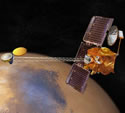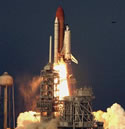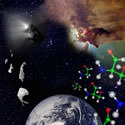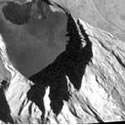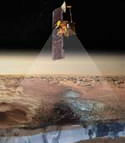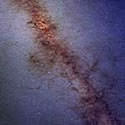
Image credit: 2MASS
One of the most groundbreaking work in astronomy being done right now is the Two Micron All-Sky Survey which is producing a high-resolution survey of the entire sky in the Infrared spectrum. Two telescopes, one in Arizona, the other in Cerro Tololo, Chile have been working non-stop for 4 years to take over 100 million individual images; these have been stitched together by computer. Infrared light has a much longer spectrum than visible light, so the images reveal objects which would normally be obscured by thick clouds of gas and dust.
Would it be possible to see the entire sky without ever stepping outside? Well, if you have access to a computer, the answer would be ?yes,? thanks to the Two Micron All-Sky Survey (2MASS), the most detailed digital map of the heavens ever made.
“These telescopes have given us the first detailed global view of our Milky Way Galaxy and the galaxies that lie beyond,” said Dr. Michael Skrutskie of the University of Virginia, the survey?s principal investigator. “The resulting databases and source catalogues are a treasure trove which will be mined for discovery by scientists and the public alike for decades to come.”
A Huge Undertaking
This tremendous task was accomplished by dividing the sky into nearly 60 thousand strips, each covering roughly the area of a toothpick held at arm?s length. Two dedicated telescopes, one in Arizona, the other in Cerro Tololo, Chile, patiently scanned these strips of sky every night, weather permitting, for nearly four years. The telescopes were built and observations conducted by the University of Massachusetts at Amherst.
While observations concluded in February 2001, the massive data reduction efforts have continued at the Infrared Processing and Analysis Center on the Caltech campus.
The 2MASS software automated what would have taken astronomers decades to do using conventional techniques. The system processed over 100 million individual frames, stitching them together into larger images while simultaneously identifying and measuring the properties of all the stars and galaxies seen within them.
An Infrared Perspective
The ?Two Micron? part of the sky survey refers to the part of the spectrum viewed by the survey?s digital eyes. Near-infrared light has a wavelength about four times longer than visible light, well beyond the limits of human vision. The survey telescopes employed sophisticated electronic cameras cooled to temperatures not far above absolute zero to see into this part of the spectrum.
The cameras simultaneously captured the sky in three different colors of infrared light. By remapping these colors into the visible colors of red, green, and blue, astronomers have produced full color images of the sky that look similar to ordinary visible light images, but show different features. Even well-known objects like the Orion Nebula take on striking new appearances.
Near-infrared light offers several advantages to astronomers. It more easily penetrates clouds of dust like those found across the Milky Way, revealing stars and galaxies that are completely hidden in visible light. It is also more sensitive to the largest population of stars in the Galaxy, the ones that are smaller and cooler than the Sun. The Two Micron All-Sky Survey observations open up the universe for studies of previously unknown stars and lay bare the internal structures of distant galaxies.
The Galaxy Inside-Out
One stunning product of the survey is an ?inside-out? view of our own Milky Way Galaxy. Constructed from the database of half a billion stars automatically identified by the processing software, it gives an unparalleled census of the Milky Way?s geography and population.
Evident in striking detail is the flat disk, punctuated by thin lanes of dense dust clouds. Towards the center we find the galactic bulge surrounding the inner nucleus of the Milky Way, long thought to harbor a supermassive black hole.
The view also extends beyond just the local Milky Way stars. Just beneath and right of the galactic center we can see the star clouds associated with our nearest neighbors: the Large and Small Magellanic clouds. A very sharp eye can even pick out a faint ?finger? of stars in the lower left side of the galactic bulge; this is the first direct image ever made of a small dwarf galaxy recently discovered to be in the process of merging with the Milky Way.
Getting the Pictures
The Two Micron All-Sky Survey has opened up new views of the universe, literally allowing people to see the whole sky in a different light. And anyone with access to a web browser can enjoy the visual feast.
The catalogues and images are distributed freely to the astronomical community and the general public via the Internet. Nearly half of the sky is currently available, and processing is ongoing for the final data release, expected in late summer 2002.
When the final sets of catalogues and images come online, they will consist of about 2 terabytes (that’s 2,000 gigabytes, or 2 million megabytes!) of computer data.
The final release will include catalogues of about half a billion stars and 2 million galaxies. Over one million research-quality images of the whole sky will be available in each of the three infrared colors observed by 2MASS. Such huge data sets represent part of astronomy’s future, as scientists learn interesting new things by analyzing terabyte-sized sets of data.
Fortunately the astronomy enthusiast has more direct access to this fantastic sky imagery. A new ?2MASS Showcase? gallery contains a selection of the very finest full color images from the survey, some at resolutions suitable for printing full posters!
In addition, the existing Image Gallery and Picture of the Week archives contain hundreds of images of interesting objects throughout the Galaxy and beyond. Even the most demanding visitors should be able to find the infrared views of their favorite objects now that the sky is online for everyone to enjoy!
Original Source: NASA News Release
